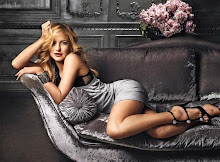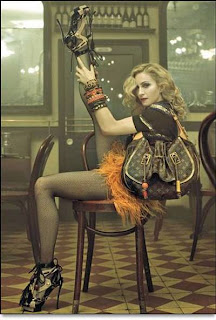
A couple of months ago Beaugarte saw an LV bag from a second hand shop. A bag-a-holic, he decided to buy the bag, not really thinking if it was a real one. He just needed a bag, that's all. Besides, it only cost him a couple hundred pesos, as compared to the Php35,000 (almost $800) retail price.
But after compliments from a dozen friends, all wanting to ask for the bag, he decided to check if the bag was authentic.
He came across this article, from WikiAnswers, telling him how to know if the LV bag he got at a cheap price was indeed genuine:
If you want the real thing or nothing at all, listen up: we're about to reveal the subtle differences between real and replica purses.
Ever heard the saying, "Imitation is the sincerest form of flattery"? Most designers would disagree, especially when it comes to premium purses. You see, most consumers can't really tell a good fake from the real thing.
Counterfeiting makes up five to seven per cent of global trade, or £450 to £500 billion. While any name brand is at risk for counterfeiting, the most commonly ripped-off labels include ARMANI,GUCCI,BURBERRY,FENDI,LOUIS VUITTON,DIOR,PRADA and KATE Spade.
So, how can you tell the difference? Experts say it's the small details that are often overlooked by manufacturers of designer knockoffs. All you need to do is take the time to pick apart the fakes to reveal their many flaws.
Watch for lining that isn't stitched in, but glued on. The same goes for labels.
The material used can also be a dead giveaway; if the signature plaid of a Burberry bag is even slightly askew, it's a fake.
Some knockoffs do take the time to stitch the lining into place; in these, look for threading that is pulling in spots. A real designer bag would have near-perfect threading.
Ask where the bag was made or look for a label. If you see "Made in China," you can pretty much pass on that purse. Do some research before you go shopping, so you know where the real thing is manufactured.
Arguably, the dominant force in designer purses is Louis Vuitton. If genuine Vuitton is what you're after, refer to list of guidelines before you buy a "bona fide" bag.
Classic Louis Vuitton monogram bags run from £400 to upwards of £1,000. If you're paying any less, you're not getting the real deal. Fakes range in price from £20 to £180.
Real Louis Vuitton purse snaps are monogrammed. Manufacturers of replica Vuittons often skip that specific.
Legit Louis bags usually start out with light leather. Over time, the leather will wear and darken.
Take a close look at the handles, which should be made of an entire strip of natural leather. When first purchased, the handle is light tan in colour; over the course of a few weeks, it should oxidize and turn into a darker, cognac colour. Fake bags don't change colour like this because the handles are usually painted.
The stitching on the handles should be clean and consistent, and should use yellow thread. The sides of the handles should be a shiny, glazed red.
The zipper pull should be brass hardware, heavy to the touch. Look for a neatly imprinted "LV" symbol on it.
The canvas of the bag shouldn't be too soft or stiff, or "oily" or shiny.
The "LV" monogram should have irregular brown lines through the gold-coloured letters, and a flower pattern. Fake monograms may be a solid colour or look too green or orange.
Ask for ID; there should be a card with the style number and name inside the bag.
Know what styles of the bags are genuine and look at the lining. Fake bags often come in styles and colours not available in the real thing and the lining will be different.
So, what do you do if you don't possess an expert eye for detail? Well, common sense is the simplest way to increase your odds of getting the real deal.
You can learn more by visiting this website:
http://reviews.ebay.co.uk/How-to-spot-if-your-Designer-bag-is-Authentic-or-a-copy_W0QQugidZ10000000001386963
Well, Happy Shopping!







 The 1980's introduced Neon to the world. Hairspray was a fashion staple, and guys started to wear earrings. Our men started wearing one earring before. Now they wear more jewelry than there female counterparts. Mohawks were associated with rebellious teens, and Madonna was the queen of fashion. She still is.
The 1980's introduced Neon to the world. Hairspray was a fashion staple, and guys started to wear earrings. Our men started wearing one earring before. Now they wear more jewelry than there female counterparts. Mohawks were associated with rebellious teens, and Madonna was the queen of fashion. She still is.
 The 90's filled fashion magazines with hip-hop fashion. The world quickly adopted baggy jeans and beanies. Macarena was danced everywhere, but not everyone understood what the song meant.
The 90's filled fashion magazines with hip-hop fashion. The world quickly adopted baggy jeans and beanies. Macarena was danced everywhere, but not everyone understood what the song meant. And now the 00's. American Idol, High School Musical, Youtube. Film and fashion magazines dictate everyone what to wear, and how to act. There are a lot of "blasts from the past", clothing styles reinvented to be more "MODERN." Crocs and low rise jeans are a staple. Men became metrosexuals. Everyone seems to be in love with David Beckham.
And now the 00's. American Idol, High School Musical, Youtube. Film and fashion magazines dictate everyone what to wear, and how to act. There are a lot of "blasts from the past", clothing styles reinvented to be more "MODERN." Crocs and low rise jeans are a staple. Men became metrosexuals. Everyone seems to be in love with David Beckham.

